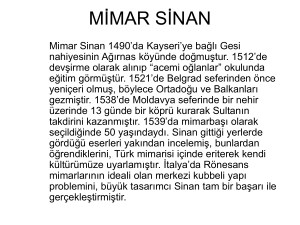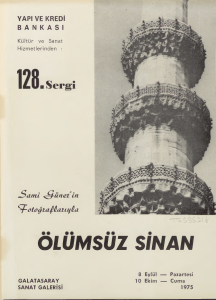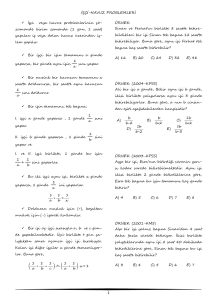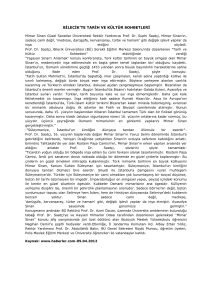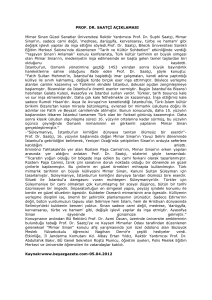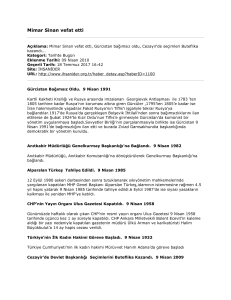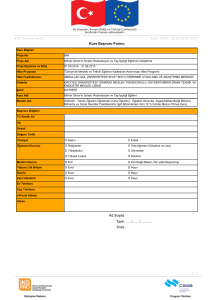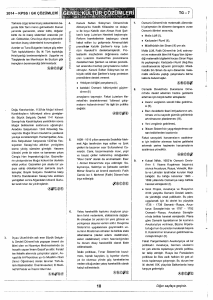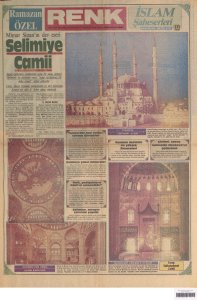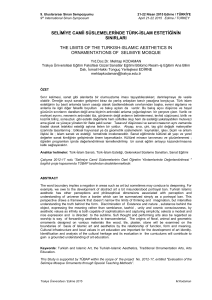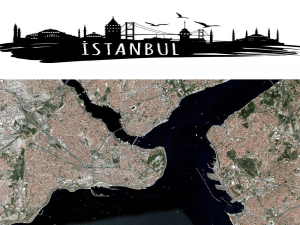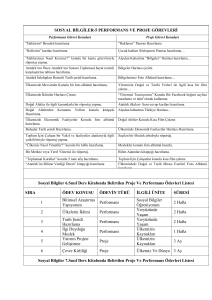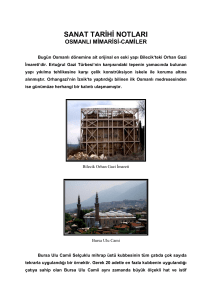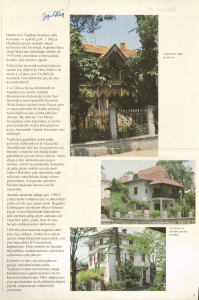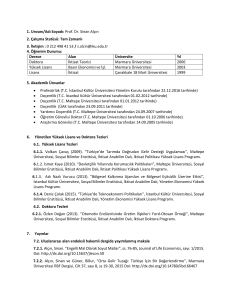Pdf Olarak Görüntüle
advertisement
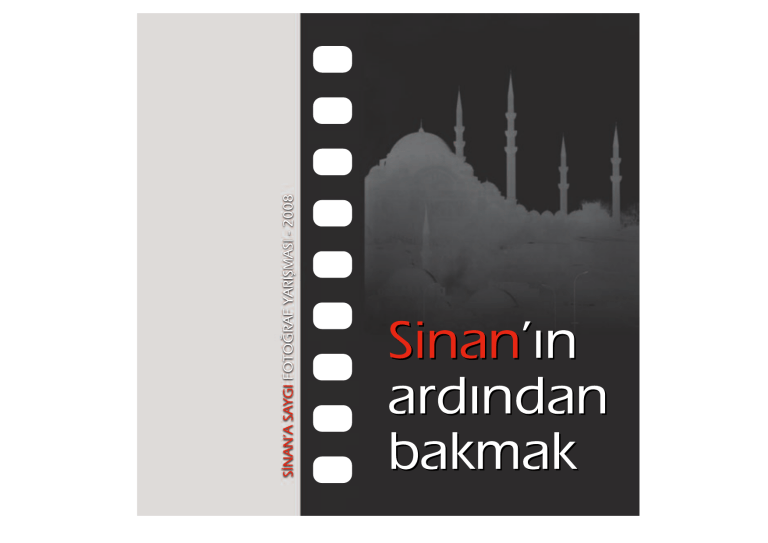
Bask›/Printing : Mas Matbaac›l›k A.fi. Hamidiye Mahallesi So¤uksu Caddesi No: 3 34408 Ka¤›thane - ‹stanbul Tel: 0212 294 10 00 info@masmat.com.tr Sinan'ın ardından bakmak SİNAN’A SAYGI FOTOĞRAF YARIŞMASI - 2008 Looking beyond Sinan RESPECT TO SINAN PHOTO COMPETITION - 2008 SİNAN'IN ARDINDAN BAKMAK İÇİNDEKİLER CONTENTS 4 Sinan'a Sayg› Foto¤raf Yar›flmas›: Yeni Bir Buluflman›n Ard›ndan... The Respect to Sinan Photo Competition: In Pursuit of a New Meeting Point 5 6 Sorumluluklar›m›z› An›msamak Remembering Our Responsibilities 8 9 Ölümsüzlü¤ün Mimar› Sinan Architect of Immortality 10 11 Foto¤raflar Photographs 12 12 Foto¤raf Karelerindeki Kubbeler: Sinan'›n Mimarl›k Miras›n›n Foto¤raflanmas› Domes in Frames: Photographing Sinan’s Architectural Heritage 40 44 SİNAN'IN ARDINDAN BAKMAK and interpretations of the diversity of Sinan's architectural heritage and to foster a wider awareness. Participants also had a chance to take Istanbul city excursions with Respect to Sinan volunteers during the duration of the competition, to gain inspiration from Sinan's soaring domes. Over 400 photographs were digitally sent to the website, www.sinanasaygi.org, from the cities where Sinan's works are located. From Istanbul to Kayseri, Edirne to Van, and Sophia to Damascus, photographs formed a visual record of Sinan from the three different viewpoints. The 159 photographs submitted to the Sinan and Life category reflected Sinan's works as they exist in people's day-to-day lives. They stand as proof to the fact that his works still form vibrant elements of the urban fabric, colourful reflections of city life for those who live and work in their shadows. Submissions to the Sinan, The Architect of Domes category brought the unity of style, creativity and values apparent in Sinan's architecture into full view, and highlighted the master's wide scale, from mosques, aquaducts and urban environments to refined wooden details. This category received the widest interest, with the 208 photographs mostly focusing on the Süleymaniye and Selimiye mosques, where Sinan built his most sublime domes, presenting these structures from some unique angles. In the Sinan: at Risk section, we aimed to draw attention to conservation issues pertinent to Sinan's works throughout the Balkans, the Middle East, and Turkey. Only 52 photos were submitted for this category, which showed us that further effort should be devoted towards creating awareness for preservation issues. Voting for the winners was open to all via the internet, with nominations being collected between March 11 and March 21, 2008. First placed in the Sinan and Life category was Uygar Korça's photo `Master's Seal', taken at Selimiye Mosque. In the Sinan: at Risk category, Aydın Mızrak's Hüsrev Pafla Mosque was selected, and in The Architect of Domes section, Muhsin Divan's photograph taken at the Süleymaniye Mosque, was chosen. The awards ceremony took place on March 27, 2008 in conjunction with the launch of an exhibition of the photos in Istanbul's Hagia Sophia. Consequently, the exhibition traveled to the Mimar Sinan House Museum in A¤ırnas, the architect's birthplace, to the Selimiye Darülhadis in Edirne, and to Forum Bornova, Forum Trabzon, and Forum Çamlık. Subsequently, the 415 photographs entered into the competition were placed in the Respect to Sinan Archive of the ÇEKÜL Foundation Information and Documentation Center. These and many other photos of Sinan's works are now located within the Respect to Sinan Archive on the project website. Visitors to the website are now also able to upload their photos and post their own views and preservation proposals. This way a comprehensive visual Sinan archive is continually enriched and kept current, providing a meeting point where common sensitivities are transformed into actions under roof of ÇEKÜL Foundation. The project has already achieved lasting results. From 2000 onwards, the Respect to Sinan Excursions and the efforts on accumulating a comprehensive inventory of his works resulted in the publication of Respect to Sinan Maps and Guides. A Respect to Sinan Library has also been created at the ÇEKÜL Foundation Information and Documentation Center, gathering together all available documents related to Sinan and his works. Finally, this catalogue forms a permanent record of the aims and result of the Respect to Sinan Photo Competition. As the 48 photographs selected from the three competition categories, they will remind us of how we perceive Sinan's magnificent heritage. In pursuit of Sinan, we wish to look forward with pride and hope, to strive for permanence in the special geography that we inhabit, and to continue this long journey together, from this meeting point on... ÇEKÜL Foundation 7 SİNAN'IN ARDINDAN BAKMAK Remembering Our Responsibilities Some people leave lasting impressions on this earth, and some can be said to foster an immortal memory of their presence. Their impact usually evolves through time. Right after an important figure's death, evaluations of their importance are immediately made, but it is sometimes difficult to maintain this level of appreciation. Changes in society and the mundane business of everyday life can mean that the limits of our remembrance may narrow in time. Having said this, it does not follow that all creative people who have made their marks on our world will eventually be forgotten. Some people have produced works that truly stand the test of time, forming a longstanding part of peoples' lives, and indeed function as the rocks on which a society is built. One unique person who since the 16th century has created such a continuous line in social memory, in spite of some undulations, is the Architect Sinan. The fact that Sinan has been remembered by all during both moments of favour and discontent, success and failure, shows how he and his life's work are considered as proofs of his immortality. As a result, when we think of our urban fabric and the wider architectural environment, and when we search for our eternal values, the Architect Sinan springs to mind. Especially during recent years, the speedy loss of identity in our towns and cities, and the insensible sacrifice of our natural, historic, and cultural heritage, has caused damage to Sinan's works. However, the extensive Respect to Sinan drive, started by the ÇEKÜL Foundation, is not only limited to protection and respect of the works of Sinan himself. This drive also seeks to highlight current undesirable developments, using hints and lessons from Sinan's continuing presence, his symbols, and his creative force that has forged perpetuity in our lives and our physical environment. If we cannot project our identity towards the future while protecting these centuries-old masterpieces, then our society must surely take a good look at itself. The risk of abandoning our authentic values must be challenged. Our natural, historic and cultural assets are resources that cannot be renewed once we pass a point of no return. The destruction of these assets, like those bequeathed to us by the Architect Sinan, is impossible to undo, and shows society's rejection of its own cultural heritage. In this way, Respect to Sinan is a drive to challenge the way we view our own cultural heritage. We aim to highlight the value of all of Sinan's works and to encourage organisations, institutions and individuals to take shared responsibility and acknowledge and promote their worth. In order to maximize interest in this process and to forge a new agenda around Sinan, what could be the correct starting point? Within the boundaries of recent developments, A¤ırnas, the place where he was born, seems to be the right starting point. In addition, this interesting settlement has the qualities and potentials for supporting the Respect to Sinan campaign fully and successfully. Various categories of the photo competition, titled The Architect of Domes, Sinan: at Risk, and Sinan and Life, have analyzed every phase of his building and production process during his long career. To compile the results of these competitions within a catalogue will become an important and decisive step towards helping to create a common awareness at the national and international level. In this context, invaluable contributions of Multi Turkmall prompts and widens the perspective of our common efforts. The hope is that Sinan's successes will leave their mark within the social presence of our society once again, reminding us of our responsibilities, and guiding decision makers towards more tangible results. Prof. Dr. Metin Sözen Head of ÇEKÜL Foundation 9 SİNAN'IN ARDINDAN BAKMAK Ölümsüzlü¤ün Mimarı Sinan 16. yüzyılda restorasyonunu yapıp çökmesin diye payanda duvarını ördü¤ü yapıda, 500 yıl sonra yapıtlarıyla yer almak için herhalde ölümsüz bir usta olmak gerekiyordu. Yapı, Ayasofya'ydı. “Ölümsüz usta” da Mimar Sinan... Ayasofya bütün görkemiyle karflımızda duruyordu. Süren yenileme çalıflmaları, insanın gözünü alamadı¤ı bu eflsiz yapının gerçek rengini, dokusunu ortaya çıkartmıfltı yer yer. ‹flte buradaki sergi salonunda açılacaktı; ÇEKÜL Vakfı'nın Sinan'ın eserlerindeki sayısız yorumu bir araya getirmek, Sinan'ın mimarlık mirasına farklı bakıfl açılarını yansıtabilmek amacıyla Multi Turkmall'ın deste¤iyle düzenledi¤i Sinan'a Saygı Foto¤raf Yarıflması'nın sergisi. Sinan'ın bugün de ayakta duran yapıtlarının üç ayrı yüzü yer alıyordu sergide. Birincisi; Sinan'ın eserleri hâlâ kent yaflamının canlı bir parçasıydı ve renkli bir yansıma olarak durabiliyordu. Bu nedenle Sinan ve Yaflam'dı bir yüzü. ‹kincisi; Türkiye ile Sinan eserlerinin bulundu¤u Balkanlar ve Ortado¤u bölgelerinde sıkça görülen koruma sorunlarının toplum belle¤inde daha fazla yer etmesi amaçlanmıfltı. Bu da karflımıza Korunamayan Sinan'ı çıkardı. Üçüncüsü de; Sinan'ın mimarlı¤ının her ölçekte kendini gösteren de¤erlerini yansıtan foto¤rafları bir araya getirmek hedeflenmiflti. Bu amaç da bizi Kubbelerin Mimarı Sinan'a götürmüfltü. Sinan’ın yapıtları ‹stanbul’dan Kayseri’ye, Edirne’den Van’a, Sofya’dan fiam’a kadar genifl bir co¤rafyaya yayılmıfltı. Biz de Multi Turkmall olarak “Forum” Alıflverifl ve Yaflam merkezlerimizi Denizli’den Trabzon’a, ‹zmir’den Diyarbakır’a, Kayseri’den ‹stanbul’a kadar 18 farklı flehire götürüyoruz. Açılmıfl olanlarla beraber, infla ve gelifltirme aflamasında olan toplam 22 projemiz bulunuyor. Bulgaristan, Romanya ve Yunanistan’daki faaliyetlerimizi de ‹stanbul merkez ofisimizden yürütüyoruz. Tüm bunları yaparken bir amacımız da yatırımlarımızın oldu¤u yerlere kültür ve sanatı götürmek, o bölgedeki kültür varlıklarına destek olmak; do¤aya, çevreye ve tarihe saygılı davranmaktır. ‹flte Sinan’a Saygı Foto¤raf Yarıflması’nda ÇEKÜL Vakfı ile bulufltu¤umuz nokta tam da burasıydı. Ayasofya Müzesi'ndeki Sinan'a Saygı Foto¤raf Yarıflması'nın sergisi açılırken de misyonumuzla sosyal sorumlulu¤umuzun örtüfltü¤ünü görmek ayrı bir heyecan ve gurur kayna¤ıydı bizim için. Kent insanlarına yeni yaflam alanları sunmak, gündelik sıradanlıkların sanatla, kültürle bezendi¤i caddeler, sokaklar, meydanlar ve yapılar oluflturmak bizim için ne kadar önemliyse; gitti¤imiz her yerdeki kültür varlıklarını bugün ifllevlerini koruyarak ya da yeni ifllevler kazandırarak yaflatmak; do¤anın, çevrenin ve tarihin insanı var eden unsurlar oldu¤unu unutmamak da o kadar gereklidir. Bizim bu alandaki katkımız da “ölümsüzlü¤ün mimarı bir usta”nın önünde yaptı¤ımız saygı durufludur ancak. Levent Eyübo¤lu Multi Turkmall CEO 10 SİNAN'IN ARDINDAN BAKMAK 13 UYGAR KORÇA Selimiye Camisi Edirne / 2002 ‘Sinan ve Yaşam’ Ödülü / ‘Sinan and Life’ Award SİNAN'IN ARDINDAN BAKMAK MUHSİN DİVAN Süleymaniye Camisi İstanbul / 2007 ‘Kubbelerin Mimarı’ Ödülü 14 ‘The Architect of Domes’ Award SİNAN'IN ARDINDAN BAKMAK AYDIN MIZRAK Hüsrev Paşa Camisi Van / 2004 ‘Korunamayan Sinan’ Ödülü ‘Sinan: at Risk’ Award 15 SİNAN'IN ARDINDAN BAKMAK SERKAN YETGİN Süleymaniye Camisi İstanbul / 2006 16 SALİH YILMAZ Süleymaniye Camisi İstanbul / 2005 SİNAN'IN ARDINDAN BAKMAK LATİF DİNÇARSLAN Mihrimah Sultan Camisi İstanbul / 2002 17 SİNAN'IN ARDINDAN BAKMAK 18 ADEM DOĞRUTEKİN Selimiye Camisi Edirne / 2006 SİNAN'IN ARDINDAN BAKMAK BENGİSU GÜRSOY Şehzade Camisi İstanbul / 2008 ŞENAY HASIRCI Selimiye Camisi Edirne / 2007 19 SİNAN'IN ARDINDAN BAKMAK LUCA ORLANDI Rüstem Paşa Camisi İstanbul / 2004 20 LUCA ORLANDI Sokollu Mehmet Paşa Köprüsü Kırklareli / 2007 SİNAN'IN ARDINDAN BAKMAK ANNIE LAMBLA Rüstem Paşa Camisi İstanbul / 2008 21 SİNAN'IN ARDINDAN BAKMAK NAİL MAHİR KORKMAZ Süleymaniye Camisi İstanbul / 2007 EMİN ÖZMEN Süleymaniye Camisi İstanbul / 2007 22 SİNAN'IN ARDINDAN BAKMAK SERKAN TURAÇ Rüstem Paşa Camisi Tekirdağ / 2007 23 SİNAN'IN ARDINDAN BAKMAK CİHAN ALDIK Kapıağası Köprüsü İstanbul / 2007 24 SİNAN'IN ARDINDAN BAKMAK GÖKMEN KANBEROĞLU Süleymaniye Camisi İstanbul / 2005 HAKAN GEVREK Kılıç Ali Paşa Camisi İstanbul / 2008 25 SİNAN'IN ARDINDAN BAKMAK BAHAR KALELİ Süleymaniye Camisi İstanbul / 2007 26 HAKAN ŞAHİN Selimiye Camisi Edirne / 2007 SİNAN'IN ARDINDAN BAKMAK OKAN YILMAZ Selimiye Camisi Edirne / 2007 27 SİNAN'IN ARDINDAN BAKMAK BERKCAN OKAR Mihrimah Sultan Camisi Üsküdar, İstanbul / 2008 HATİCE BARBAROS Süleymaniye Camisi İstanbul / 2007 ERKUT ERKEK Süleymaniye Camisi İstanbul / 2008 MUSTAFA ÖZDEN Süleymaniye Camisi İstanbul / 2002 28 SİNAN'IN ARDINDAN BAKMAK KEMAL AYGÜN Süleymaniye Camisi İstanbul / 2006 BERNA AKGÜN Selimiye Camisi Edirne / 2005 29 SİNAN'IN ARDINDAN BAKMAK SENA ÖZFİLİZ Mihrimah Sultan Camisi Üsküdar, İstanbul / 2007 30 MEHMET KARABULUT Mağlova Kemeri İstanbul / 2006 SİNAN'IN ARDINDAN BAKMAK BERRAK ÇELİK Kılıç Ali Paşa Camisi İstanbul / 2008 31 SİNAN'IN ARDINDAN BAKMAK İSMAİL TÜTÜN Süleymaniye Evvel Medresesi İstanbul / 2006 32 BAHAR KALELİ Süleymaniye Rabi Medresesi İstanbul / 2007 SİNAN'IN ARDINDAN BAKMAK BAHAR KALELİ Sultan Süleyman (Büyükçekmece) Köprüsü İstanbul / 2007 EMRE TÜNGÜ Mihrimah Sultan Camisi Üsküdar, İstanbul / 2008 33 SİNAN'IN ARDINDAN BAKMAK İ. GÜLTEKİN ALKURT Sultan Süleyman (Büyükçekmece) Köprüsü İstanbul / 2007 34 ERCÜMENT AKAT Sultan Süleyman (Büyükçekmece) Köprüsü İstanbul / 2006 SİNAN'IN ARDINDAN BAKMAK ERKAN YURT Sultan Süleyman (Büyükçekmece) Köprüsü İstanbul / 2007 DERYA ŞENGÜLEN Sultan Süleyman (Büyükçekmece) Köprüsü İstanbul / 2008 35 SİNAN'IN ARDINDAN BAKMAK CEM REŞAT DOĞANCA Süleymaniye Camisi - İstanbul / 2008 HAKAN GEVREK Nişancı Mehmet Paşa Camisi - İstanbul / 2008 MAHİR GÜNDAY Süleymaniye Camisi - İstanbul / 2007 EMEL SALEM Hüsrev Paşa Camisi - Halep / 2008 36 SİNAN'IN ARDINDAN BAKMAK ÇETİN YURTSEVER Topkapı Sarayı Mutfakları İstanbul / 2007 AYHAN ALTUN Mağlova Kemeri İstanbul / 2007 37 SİNAN'IN ARDINDAN BAKMAK ŞEHRİ KARTAL Rüstem Paşa Kervansarayı İstanbul / 2008 MUZAFFER ÖZGÜLEŞ Şehzade Camisi İstanbul / 2007 TUĞBA SIVACI Atik Valide Medresesi İstanbul / 2008 MESUT KAPLAN Hüsrev Paşa Camisi Van / 2008 38 SİNAN'IN ARDINDAN BAKMAK Foto¤raf Karelerindeki Kubbeler: Sinan'ın Mimarlık Mirasının Foto¤raflanması Sinan'ın eserleri 16. yüzyılda infla edilmeye bafllandıkları dönemden itibaren, seyahatnamelerde, gravürlerde ve resimlerde sıkça yer buldu. 19. yüzyılda foto¤raf tekni¤inin geliflmesiyle birlikte, Sinan'ın kubbeleri foto¤raf karelerine yansıdı. Sinan'ın eserlerinin foto¤raflanması, hem mimarlık tarihi hem de foto¤rafçılık alanında çok yönlü öneme sahip. Bugün yarısından ço¤u yokolmufl, kalanlarının da önemli bir kısmı de¤iflikliklere u¤ramıfl eserlerin pek ço¤unun özgün hallerini sadece foto¤raflarda bulabiliyoruz. Onarımlar da dahil olmak üzere, Sinan'ın eserlerinin maruz kaldı¤ı de¤iflikliklerin büyük ço¤unlu¤u yıllarca hiç bir kayıt olmadan gerçekleflti. Sinan eserlerinin günümüzdeki görünümlerinde, Sinan'ın tasarımları ile sonradan müdahelelerin arasındaki sınırları belirlemekte zorlanıyoruz. Foto¤raflar, bu durumdaki sayısız yapının tarihsel öykülerini yazabilmek için belge de¤eri taflıyorlar ve kimi zaman restorasyonlarda bile kaynak olarak kullanılıyorlar. Örne¤in, Kılıç Ali Pafla Camisi'nin 1990'l› yıllardaki restorasyonu sırasında, son cemaat yerinin reva¤ında yapılan de¤ifliklikler, geçen yüzyılda çekilmifl bir foto¤rafa dayanılarak gerçekleflmifltir. Restorasyona kaynaklık eden egzotik foto¤raf karesinde, caminin avlusunda tezgah kurmufl arzuhalcileri görürüz. Ya da, sanat tarihi kitaplarında, arafltırmacıların Osmanlı mimarlı¤ını incelerken siyah beyaz bir foto¤rafa bakarak Kılıç Ali Pafla Camisi'nin barok tarzdaki kalem ifllerini nasıl tespit ettiklerini ve yorumladıklarını okuruz. Foto¤raflar, yapıların çeflitli dönemlerdeki durumlarını belgelemenin ötesinde, ister profesyonel amaçla ister amatörce çekilmifl olsunlar, sanatçılarının kiflisel deneyimlerini yansıtan yapıtlar olarak da önem kazanır. Sinan'ın eserlerinin boyutlarının, konumlarının ya da türlerinin etkileyici çeflitlili¤i, foto¤rafçıların kiflisel yorumlarını yansıtabilmeleri için sonu gelmez bir kaynaktır. fiehrin çöküntü bölgelerinde kalmıfl eserleri yaflamla içiçe yansıtan sosyal gerçekçi karelerden, aynı eserleri evrensel sanat yapıtları olarak de¤erlendiren örneklere kadar uzanan sonsuz bir çeflitlilik sözkonusu. Mimari eserler, foto¤rafçıların kendi yorumlarını yansıtan foto¤raf karelerinde güçlü sembollere dönüflüyor ve toplumun hafızasına yerlefliyorlar. Mimarları ve eserlerini, ço¤unlukla popüler ya da mimarlık tarihi yayınlarında metinlere efllik eden bu foto¤raflar aracılı¤ıyla tanıyoruz. Sinan'ın baflyapıtları da toplumla, öncelikle ikonik foto¤raf karelerinde bulufluyor. Süleymaniye'nin bir tepenin üstünden, Haliç'in sisi ve Bo¤az vapurlarının dumanlarının arasından yükselifli, ya da Kadırga'daki Sokollu Camisi'nin merdivenlerinin etkileyici perspektifi, sayısız foto¤rafta bizim için bu yapıları tanımlıyor. Sinan'ın eserlerinin foto¤raf karelerinde yorumlanmasını, Osmanlı ‹mparatorlu¤u sınırlarında ilk foto¤rafların çekildi¤i 1850'lere kadar götürmek mümkün. 19. yüzyılda Osmanlı topraklarında gezinen batı kökenli ilk foto¤rafçılar, egzotik manzaraları, ‹stanbul'un batı flehirlerine hiç benzemeyen mahallelerini, Galata Köprüsü'nü, Haliç'in yelkenlilerle dolu görüntülerini çekiyorlardı. Sinan'ın eserleri, foto¤raflarda öncelikle bu panoramik flehir manzaraları içinde görülmeye bafllandı. ‹stanbul ve Edirne gibi büyük ve tarihi flehirlerin foto¤rafları albümlerde de toplandı. 1890 yılında basılan, ço¤unlu¤u Kargapoulos tarafından çekilmifl foto¤raflardan oluflan Souvenir D’Adrinople [Edirne Albümü] ve aynı yıl Abdullah Biraderler’in bastı¤ı ‹stanbul, Bursa ve Edirne foto¤raflarını içeren albüm ilk örneklerdendir. Selimiye Camisi, Edirne'nin tartıflmasız simgesi olarak belirirken, aynı dönemin ‹stanbul albümlerinde Süleymaniye, Ayasofya ve Sultanahmet Camisi'nin gölgesinde kalmıfl gibidir. Albümde Ayasofya ve Sultanahmet iç ve dıfl görüntüleri ile öne çıkarken, Süleymaniye Camisi sadece panoramada görkemli bir figür olarak belirir. 40 Foto¤raflar mimari eserleri albümler gibi kartpostallara da taflıdı. Türkiye'yi konu alan kartpostalların en eskileri 1890'li yıllara kadar gidebiliyor. `Büyük Tur' olarak adlandırılan, Türkiye'yi de kısmen içine alan gezilerinden hatıra olarak alınan ve gönderilen kartpostallar büyük kolaylıktı. Resimli bir kartpostal ile gezileri yollanan mektuplarda anlatmanın zorlu¤u da ortadan kalkıyordu. Kartpostallar büyük ölçüde bu amaca hizmet ettiklerinden olsa gerek, çok popüler oldukları 1890'lı ve 1920'li yıllar arasında, ço¤unlukla manzaraları ve mimari anıtları resmediyorlardı. ‹stanbul'da kartpostal basımı ile u¤raflan çok sayıda isim içinde, Max Fruchterman 30 yıla yaklaflan meslek yaflamı ve bastı¤ı yüzlerce farklı kartpostal ile öne çıkar. Fruchtermann'ın ilk SİNAN'IN ARDINDAN BAKMAK kartpostallarında, mimari konularda Sinan'ın eserlerinden daha çok, Bizans yapılarını ve Bo¤az kıyısındaki anıtsal Osmanlı camilerini görürüz. Süleymaniye bile 19. yüzyılın sonlarına kadar çıkan kartpostal serilerinde sadece Galata Kulesi ve Beyazıt Yangın Kulesi gibi yüksek noktalardan çekilen panoramik foto¤raflarda belirir. Kartpostallar hem üreticilerin hem de alıp kullananların milliyetlerinden do¤an ilgilerini yansıtıyordu. Avrupalı konuklarının gözünde ‹stanbul, hep yok olan Bizans ‹mparatorlu¤u'nun baflkenti olarak kalmıfl, ancak üzerine Osmanlı egzotizmi eklenmiflti. Di¤er pek çok Osmanlı yapısı gibi, Sinan'ın Süleymaniye ve Kılıç Ali Pafla camileri gibi ünlü ve görkemli yapıları da daha çok abdest alan müslümanlar ya da tezgah kurmufl arzuhalciler gibi egzotik figürlerin arkasında görülür. Ancak ilerleyen yıllarda, Süleymaniye'nin Ayasofya ve Sultanahmet gibi ‹stanbul'un simge yapılarından biri haline geldi¤ini görürüz. Bu dönemde, Sinan'ın eserleri için gittikçe yerleflik hale gelecek foto¤raf kareleri de ortaya çıkar. Haliç'in sisi ve vapurların bacalarının dumanları arkasında, Rüstem Pafla ve Süleymaniye camilerinin birbiri ardında ve ahenkli görüntüsü, Süleymaniye'nin Haliç'in pitoresk manzarasının üstünde anıtsal bir da¤ gibi yükselifli ya da Beyazıt Yangın Kulesi'nden Süleymaniye Camisi'nin görünümü, o günlerden bu yana sürekli popülerdir. Süleymaniye'nin iç mekân foto¤rafları da kartpostal serilerinde bu simge yapının görüntülerini tamamlar. Ancak Sinan'ın mimarlı¤ına karflı özel bir ilginin oldu¤u söylenemez, yapıların altında Sinan'ın eseri oldukları bile dile getirilmiyordu. 1900'lü yıllarda ‹stanbul'u ziyaret eden mimariyle ilgilenen gezginler sadece kartpostal almıyorlar kendi foto¤raflarını da çekiyorlardı. Bu tür foto¤raf koleksiyonlarının içeriklerine ulaflmak zor olsa da ünlü sanatçı ve mimarların basılmıfl eserlerinden sınırlı bir izlenim edinebiliniyor. Le Corbusier'in ‹stanbul'u da içine alan yolculu¤undan foto¤raflar, ‹stanbul'a gelen ziyaretçilerin görkemli mimari eserler içinde Sinan'ın yapılarına olan özel ilgisini de gösterir. Daha sonra çok ünlü bir mimar olacak Le Corbusier, foto¤raf ve eskizlerinde Sinan'ın eserlerindeki plastik kaliteyi duyarlılıkla gözlemler. Cumhuriyet'in kurulması ile birlikte, Sinan'ın eserleri daha farklı bakıfl açılarıyla da foto¤raflara yansır. Genç cumhuriyetin ve onun gelecek ideallerinin dünyaya tanıtılması, 1930 ve 1940'larda öncelikli hedefler arasındadır. Ülkenin sahip oldu¤u do¤al ve arkeolojik zenginlikler, yeni kurulan fabrikalar, açılan demiryolları ve köprüler, tanıtım amaçlı yayınlarda foto¤rafların konusu olurlar. Bu tür yayınlar arasında en önemlisi olan La Turquie Kemaliste [Kemalist Türkiye] dergisi içindeki foto¤rafların önemli bir kısmı Othmar Pferschy'e (1898-1984) aittir. Pferschy Avusturya'da do¤mufl, 1926 yılında Türkiye'ye geldikten sonra devlet için ülkeyi dolaflarak binlerce kare foto¤raf çekmifltir. Sinan'ın eserlerinin foto¤rafları, La Turquie Kemaliste içinde, Türkiye'nin do¤al ve tarihi güzelliklerine ayrılmıfl bölümde sıklıkla yer alır. Bu bölümde, Ayasofya'nın foto¤rafları pek görülmezken Selimiye ve Sultanahmet simge yapılar olarak öne çıkar. Pferschy, sürekli tekrarlanan ikonikleflmifl karelere ek olarak, Sinan'ın eserlerini dönemin modern mimarlık anlayıflıyla paralellikler kuracak biçimde de foto¤raflar. Foto¤rafları, çizgilerin ve hacimlerin durulu¤unun hakim oldu¤u mimari kompozisyonlara odaklanır. Ernst Egli'nin 1954 yılında basılan, Sinan hakkında yazılmıfl ilk monografi sayabilecek Sinan Der Baumeister Osmanische Zeit [Sinan Osmanlı Döneminin Ustası] adlı kitabının foto¤raflarını da Pferschy çeker. Sinan'ın eserlerinin foto¤rafları, özenle seçilmifl ve basılmıfl 120 adet siyah beyaz foto¤raf ile, ilk kez bu kitap içinde kapsamlı biçimde yayınlanmıfltır. Egli'nin Sinan'ın mirasını yapı tiplerine göre sınıflayan ve de¤erlendiren yaklaflımı foto¤raflara da yansır. Yapılar ve mimar elemanlar, kendi bütünlü¤ü içinde tekil yapıtlar olarak mimarlık foto¤rafçılı¤ı perspektifinden verilir. 1960'lı yıllardan itibaren Türkiye'yi tanıtım amaçlı yayınların, bu kez popüler tanıtıma ve turizme yönelik olarak yo¤unlaflması, Sinan'ın mimarlık mirasını da kapsadı. Bu anlamda Ara Güler (d. 1928), Pferschy'in ardından akademisyenlerle sürekli çalıflarak Sinan'ın mirasını foto¤raflayacak ilk isimlerdendir. Güler 1960'lı yıllarda dünya basınında önemli bir yer edinerek, Afrodisyas'tan Nemrut Da¤ı'na kadar uzanan, Sinan'ın da içinde oldu¤u kültürel miras aracılı¤ıyla Türkiye'nin tanıtılmasında rol oynadı. Bu foto¤rafların toplumla paylaflılmasında, Sinan'ın Türkiye'nin ulusal gururu ve evrensel kültüre bir katkısı olarak görülmesi belirleyici oldu. Sinan'ın mimarlık mirasını konu alan ilk foto¤raf sergileri, 1972 yılında Dıfliflleri Bakanlı¤ı tarafından Güler'in foto¤raflarıyla, uluslararası platformlarda ve Avrupa ile Arap ülkelerinde Türkiye'yi prestijli biçimde tanıtmak amacıyla düzenlenmiflti. 41 SİNAN'IN ARDINDAN BAKMAK Aynı yıllarda Sinan'ı kapsamlı biçimde foto¤raflayan di¤er bir önemli isim Sami Güner'dir (1915-1991). Güner foto¤rafçı olarak çalıfltı¤ı yıllar boyunca, Sinan'ın eserlerinden yelken yarıfllarına, 19 Mayıs törenlerinden köyde çamaflır yıkayan kadınlara kadar foto¤raf karesine girebilecek herfleyi konu olarak iflledi. Güner'in Sinan eserleri foto¤rafları, çeflitli türde yayınlar içinde da¤ınık olarak kullanıldıktan sonra ilk önce sergilerde bir araya geldi. ‹stanbul'da Yapı Kredi Galatasaray Sanat Galerisi'nin ardından, sergiler 1975 ile 1977 yılları arasında ‹zmir, Adana ve Ankara'yı dolafltı. 1970'lerin ardından, 1988 yılındaki Mimar Sinan Uluslararası Anma Yılı, Sinan'ın eserlerini konu alan arafltırmalar ve foto¤raflar için bir dönüm noktasıdır. Anma Yılı kapsamında, Sinan ve eserleri üzerine çok sayıda ve çeflitlilikte yayın gerçeklefltirildi. Özellikle Sinan'ın mimarisinin toplu de¤erlendirmelerini yapan, de¤iflik bafllıklar altında sunulan kitaplar için, kapsamlı biçimde eserlerin foto¤rafları çekildi. Sinan'ın mimarisi konusunda önde gelen akademisyenlerden Aptullah Kuran'ın Mimar Sinan adlı monografisi, Anma Yılı'nın hemen öncesinde 1986 yılında basıldı. Yayımlanmasından beri bu kitap ilgili hemen her kütüphanede bulunan temel bir baflvuru kayna¤ı. Ara Güler ve Mustafa Niksarlı tarafından çekilmifl 250'den fazla siyah beyaz foto¤raf, sayısız okuyucunun belle¤inde ilk Sinan imgesini yaratıyor. Kuran'ın monografisinin a¤ırlı¤ını oluflturan mekân ve yapı tarihi tasvirleri gibi, foto¤raflar da sade ve tanımlayıcıdır. Öte yandan, Güler bu kitapta da yer alan foto¤raflarıyla sergiler açmaya devam etti. Türkiye'nin küresel dünyaya ekonomik ve sosyal alanlarda hızla açıldı¤ı 1980'li yıllarda, Osmanlı mirası hem ulusal gurur kayna¤ı hem de tanıtım alanıydı. Dönemin hükümetinin önemli bir kültürel ve politik adım olarak gördü¤ü `Muhteflem Süleyman Sergisi' 1987 ile 1988 yılları arasında, ABD`nin Washington, Chicago ve New York kentlerinde düzenlendi. Güler'in “Osmanlı Mimarlı¤ı'nın Altın Ça¤ı: Sinan” adlı foto¤raf sergileri de bu etkinlik ile eflzamanlı olarak aynı kentlerde gerçeklefltirildi. Türk Mimarisinin Geliflimi ve Mimar Sinan adlı monografinin ardından, Metin Sözen'in, Sinan'ın mimarlık mirası üzerine ikinci kapsamlı çalıflması olan Sinan Architect of Ages [Ça¤ların Mimarı Sinan] ve Arts in the Age of Sinan [Sinan'ın Ça¤ında Sanat] adlı kitapları da 1988'de Sinan'ı Anma Yılı kapsamında basıldı. Sözen, yaptı¤ı çalıflmaların özünü aktaran metinin ardından, foto¤raflarla Sinan'ın mirasına kapsamlı bir bakıfl açısı sunar. Sözen'in birikimi ile Güner'in foto¤rafçılık deneyimine dayanan ve hava çekimlerinden, mimari detayların yakın çekimlerine kadar genifl bir perspektifteki bu foto¤raflar, bilinen kompozisyonların dıflına çıkarak Sözen'in Sinan'a bakıflını da yansıtır. Sinan'ın kubbelerinin birbirleri ve flehir ile olan iliflkileri panoromalarla da saptanır. 42 Sinan'› Anma Y›l›, yeni birikimlerin ortaya ç›kmas›n› da sa¤lad›. Ulya Vogt-Göknil'in 1987 y›l›nda yay›mlad›¤› Mimar Sinan adl› kitab›nda, Eduard Widmer'in ço¤unlukla ‹stanbul'da çekti¤i siyah beyaz cami foto¤raflar›, Sinan'›n eserlerindeki strüktürel mant›¤› her ölçekte an›tsallaflt›rd›. Mimarl›k tarihçisi ve foto¤rafç›s› Aras Neftçi (d.1962) de, ‹stanbul'daki Sinan eserleri foto¤raflar›yla 1989 y›l›nda `Yaflayan Sinan' adl› sergisini açt›. Vak›flar Genel Müdürlü¤ü'nün yay›mlad›¤› Mimarbafl› Koca Sinan adl› kitab›n foto¤raf albümü ise, Sadi Bayram taraf›ndan ‹stanbul ve Anadolu'da birbuçuk ayl›k k›sa bir süre içinde çekildi. Sanatsal kayg›lar› ve bask› kalitesi yüksek olmasa da Sinan'›n Türkiye'deki mimarl›k miras›n›n 1988 y›l›ndaki foto¤rafik haritas›n› ç›karmas› ile belge de¤erindir. Bu foto¤raflar sergiler ile de 1988 y›l› sonundan itibaren Türkiye'yi dolaflt›. SİNAN'IN ARDINDAN BAKMAK Domes in Frames: Photographing Sinan's Architectural Heritage Sinan's masterpieces have often appeared in travelogues, etchings, and pictures since their construction in the 16 th century. Following the development of photography in the 19 th century, Sinan's domes were captured within photo frames. Photographing Sinan's works has multidimensional importance in the field of architectural history and photography. More than half of Sinan's works have disappeared and a significant number of the rest have been considerably transformed. In many cases, the authentic character of the buildings is only available in photos. Changes imposed upon Sinan's architecture over the years, including restorations, were mostly carried on without records. Subsequently, it is difficult to determine the border between Sinan's original designs and later interventions. For this reason, photographs have become invaluable visual documents for architectural history. They have been occasionally used as references during restorations. For example, during the restoration of the Kılıç Ali Pafla Mosque in the 1990s, reconstruction of the portico based on a photograph taken in the previous century. On this exotic photo, we see the petition-writers lining the courtyard with their stands. Or, art history books record how art historians referred to a black and white photograph of the Kılıç Ali Pafla Mosque, to locate and interpret its baroque style ornaments. Photographs, professional or amateur, are also considered as works that reflect the artist's individual experiences in addition to being historical documents for architectural history. The diversity in dimensions, locations, or typology of Sinan's works has served as an endless resource for artistic expression in photography. From socio-realistic picture photos reflecting the buildings intermingled within daily life in slums, to examples that reinterpret them as universal works of art, there is an endless diversity in these photos. In photographers' frames, architectural monuments become powerful symbols that are embedded in public memory. Photographs that are accompanied with popular or professional texts on architectural history introduce architectural works to us. Sinan's masterpieces are mostly introduced to the public by iconic photographs too. View of Süleymaniye rising high on a hill in the mist of the Golden Horn and beyond the smog from the boats of the Bosphorus, or impressive perspectives from the stairs of the Sokollu Mosque in Kadırga, became synonymous with these buildings in countless photographs. The earliest photos of Sinan's works go back as early as the first photos taken in the Ottoman Empire in 1850s. Early photographers of Western origin who traveled in Ottoman territories documented the exotic views from Istanbul neighborhoods that differ from western cities, the Galata Bridge, and views of the Golden Horn with its sailboats. Sinan's masterpieces began to appear in these panoramic views early on. Photographs of vistas from large and historic cities such as Istanbul and Edirne were collected and published in photo albums. The Souvenir D’Adrinople, composed of photographs mostly taken by Kargapoulos and another album by Abdullah Brothers covering ‹stanbul, Bursa ve Edirne, both published in 1890, are among the first examples for Ottoman cities. In such photo albums, as the Selimiye rises as the unchallenged symbol for Edirne, in the Istanbul albums, the Süleymaniye seems to be overshadowed by the Hagia Sophia and the Sultanahmet. As the interior and exterior views from the Hagia Sophia and the Sultanahmet Mosque were frequently used, the Süleymaniye remains as only an impressive figure in panorama. 44 As in albums, photos of architectural monuments appeared on postcards as well. The oldest postcards of Turkey can be dated back to the 1890s. Postcards, which were souvenirs taken and sent from the journeys called the Grand Tour partially including Turkey, provided a great facility for travel. A picture postcard eliminated the difficulty of describing travel by long letters. Probably because of this, postcards mostly included panoramas and architectural monuments between the 1890s and the 1920s, during their most popular period. Among those who were occupied with postcard printing in Istanbul, Max Fruchterman stands out as an important figure, with his almost 30-year career and hundreds of postcards of different varieties. In the earlier postcards by Fruchterman, Byzantine buildings and monumental Ottoman mosques along the Bosphorus were seen more often than Sinan's masterpieces. In his late 19 th century series, even the Süleymaniye appear only in panoramic views photographed from the higher points in the city, SİNAN'IN ARDINDAN BAKMAK such as from the Galata Tower and the Beyazıd Fire Tower. Postcards reflected the interests of the producers and customers that were related to their nationalities. Until then, in view of the European visitors, Istanbul had remained as the capital of the now non-existing Byzantine Empire, yet with added Ottoman exoticism. As in many other Ottoman buildings, Sinan's majestic structures, such as the Süleymaniye and the Kılıç Ali Pafla mosques, appear as backdrops for such outlandish figures as Muslim men performing ablutions or petition-writers by their stands. However, during the later years in this period, the Süleymaniye became a symbol building of Istanbul as the Sultanahmet and Hagia Sophia. At this time, Sinan's architecture started to appear more often and became more deep-seated in postcards. Beyond the foggy Bosphorus and peering behind the smog of the boats, the harmonic succession of the Rüstem Pafla and the Süleymaniye mosques in imagery, the scene of the Süleymaniye rising like a monumental hill above the picturesque view of the Golden Horn, or its impressive appearance in vistas from the Beyazıt Fire Tower have been the most popular views continually since those early days. In postcard series, the interior photographs from the Süleymaniye completed imagery of this symbol building. Nevertheless, we cannot conclude that there was a special interest in Sinan's architecture, since Sinan was not even identified as the architect in these shots. During 1900s, travelers not only profusely bought such postcards, but they also took photographs themselves. Even though it is difficult to reach the contents of such personal collections, one can still make limited deductions based on publications by some well-known artists and architects. The photographs from Le Corbusier's travels, which also included Istanbul, display the visitor's special interest in Sinan's works, among many other majestic architectural examples in the city. Le Corbusier, who became a very famous architect later on, revealed the plastic quality of Sinan's works with sensitivity, in his photographs and sketches. Following the establishment of the Republic, Sinan's architecture was reflected from new and different viewpoints. The presentation of the young republic and its ideals to the world gained precedence in the 1930s and the 1940s. The natural and archaeological resources and wealth of the country, newly established factories, recently built railroads and bridges constituted the subject matter for the photographic presentation in various publications. A large section of the photographs in La Turquie Kemaliste [The Kemalist Turkey], the most prominent publication of the Republic, were by Othmar Pferschy (1898-1984). Born in Austria, Pferschy came to Turkey in 1926; toured the country for the state and took thousands of photos. In La Turquie Kemaliste, shots from Sinan's works often appear within the section reserved for the natural and historic beauties of Turkey. Here, the Selimiye and the Süleymaniye were prominent as symbolic structures, while views of the Hagia Sophia became rare. In addition to his iconic, recurrent shots, Pferschy photographed Sinan's masterpieces in parallel with modern architectural concepts. His photographs focused on architectural compositions that brought the clarity of lines, forms, and volumes to the foreground. Pfesrchy also took the photos for Ernst Egli's Sinan Der Baumeister Osmanische Zeit [Sinan the Master of the Ottoman Period], which can be considered to be the first monogram written about Sinan, published in 1954. 120 black and white photographs that were carefully chosen and published were the first comprehensive visual presentation of Sinan's architectural legacy. As seen here, photographs reveal structures or architectural elements within their own unity, from the perspective of architectural photography. Starting with the 1960s, publications that aimed at presenting Turkey concentrated more on popular promotion and tourism, and also included Sinan's architectural heritage. Within this context after Pferschy, Ara Güler (b. 1928) was the first photographer who built a comprehensive Sinan archive. By 1960s, Güler had achieved a reputable place in world press, and he had acquired a significant role in representing Turkey by way of its cultural heritage from Aphrodisias to Mount Nemrut, including Sinan as well. Perceving Sinan as a source of national pride and considering him as a contribution of the nation to the universal human culture prompted and shaped the presentation of photographs of Sinan's architectural heritage. The first photography exhibition on Sinan's architectural heritage was organized by the Ministry of Foreign Affairs to present Turkey in a prestigious manner with Ara Güler's photographs in European and Arab countries in 1972. In the same period, another artist who photographed Sinan in a comprehensive way was Sami Güner (1915-1991). During the years 45 SİNAN'IN ARDINDAN BAKMAK he worked as a photographer, Güner captured numerous subject matters, from Sinan's structures to sailing competitions, from May 19 th Youth Day celebrations to village women doing laundry. Following the use of his work on Sinan in publications of various kinds, they were first brought together in a special exhibition. After the initial display in the Yapı Kredi Galatasaray Art Gallery in Istanbul, the exhibition was taken to other locations such as Izmir, Adana, and Ankara, between 1975 and 1977. After the 1970s, `1988 - the Architect Sinan International Commemoration Year' became a milestone for research and photography on Sinan's works. Within the scope of the Commemoration Year, a large number and variety of publications on Sinan and his works materialized. Sinan's arhitecture was photographed comprehensively for these publications, which evaluate him and his architecture. A monogram titled Mimar Sinan by Aptullah Kuran, a leading academician on Sinan's architecture, was published in 1986, right before the Commemoration Year. Since its publication, this book has become a fundamental source, to be found in every related library. With over 250 black and white photographs by Ara Güler and Mustafa Niksarlı, it recreates the first imagery of Sinan for readers. Like the narrative of the history and architecture of the buildings by Kuran, photographs are also more descriptive. On the other hand, Güler continued opening exhibitions by further enriching his archive with the photographs he took for this book. The Ottoman heritage was seen as a national source for pride as well as a publicity feature for Turkey during the 1980s, at a time when the country was exposed more and more to the global world economically and socially. During 1987 and 1988, `The Age of Sultan Suleyman the Magnificent' was organized and carried to several cities, such as Washington D.C., Chicago, and New York, in the USA. Simultaneously, Ara Güler's photography exhibition, titled `The Golden Age of Ottoman Architecture: Sinan' also toured the same cities. Following Türk Mimarisinin Geliflimi ve Mimar Sinan [Development of Turkish Architecture and Architect Sinan], Sözen published his second monographic works Sinan, the Architect of Ages and Arts in the Age of Sinan within the scope of the Sinan Commemorative Year, in 1988. After a summary of his academic work on Sinan with a concise text, he presents a comprehensive viewpoint for Sinan with photographs. These photographs, basing on Sözen's academic guidance and Güner's photography experience, range in scale from air shots to close up views of architectural details. As the photographs go beyond prevalent compositions they offer Sözen's view of Sinan. The interrelations of Sinan's domes with the city are captured in the panoramic views of the urban environment. The Commemoration Year prompted new photographers to photograph Sinan's architecture. Ulya Vogt-Göknil published a monogram titled Mimar Sinan in 1987. Black and white photographs of Eduard Widmer in this book, which mostly belong to mosques in Istanbul, monumentalizes the logic of structure in various scales. Architectural historian and photographer Aras Neftçi (b. 1962) opened an exhibition titled `Yaflayan Sinan ' [Sinan Alive] in 1989 with his photos of Sinan's Works in Istanbul. On the other hand, the photos of the book Mimarbafl› Koca Sinan [Master Architect the Great Sinan] by the Directorate of Pious Foundations were taken by Sadi Bayram within a short period of only one and a half months in Istanbul and Anatolia. Even though its artistic concerns and publication quality may not quite be at par with others, it is certainly significant as a photographic survey of Sinan's architectural heritage in Turkey in 1988. These photographs also toured the country with exhibitions. 46 For the Commemoration Year, the Istanbul Metropolitan Municipality organized an exhibition, with a publication to follow, using photographs by Reha Günay (b. 1937). With his exhibitions, books, and his identity as an academician, Günay is a prominent name
